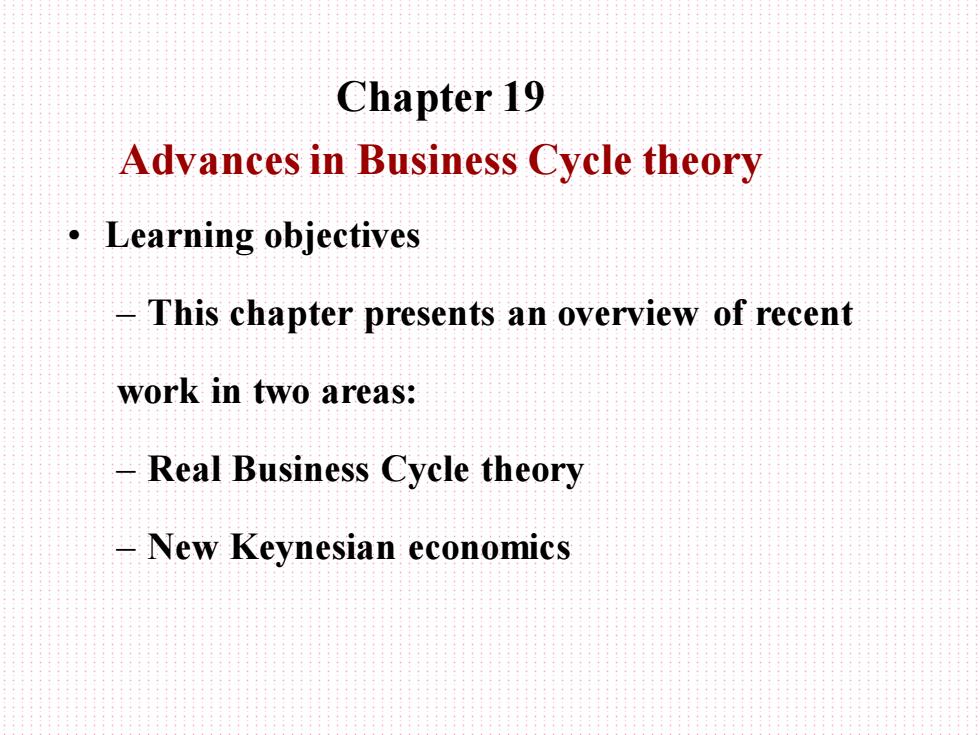
Chapter 19 Advances in Business Cycle theory Learning objectives This chapter presents an overview of recent work in two areas: Real Business Cycle theory -New Keynesian economics
Chapter 19 Advances in Business Cycle theory • Learning objectives – This chapter presents an overview of recent work in two areas: – Real Business Cycle theory – New Keynesian economics
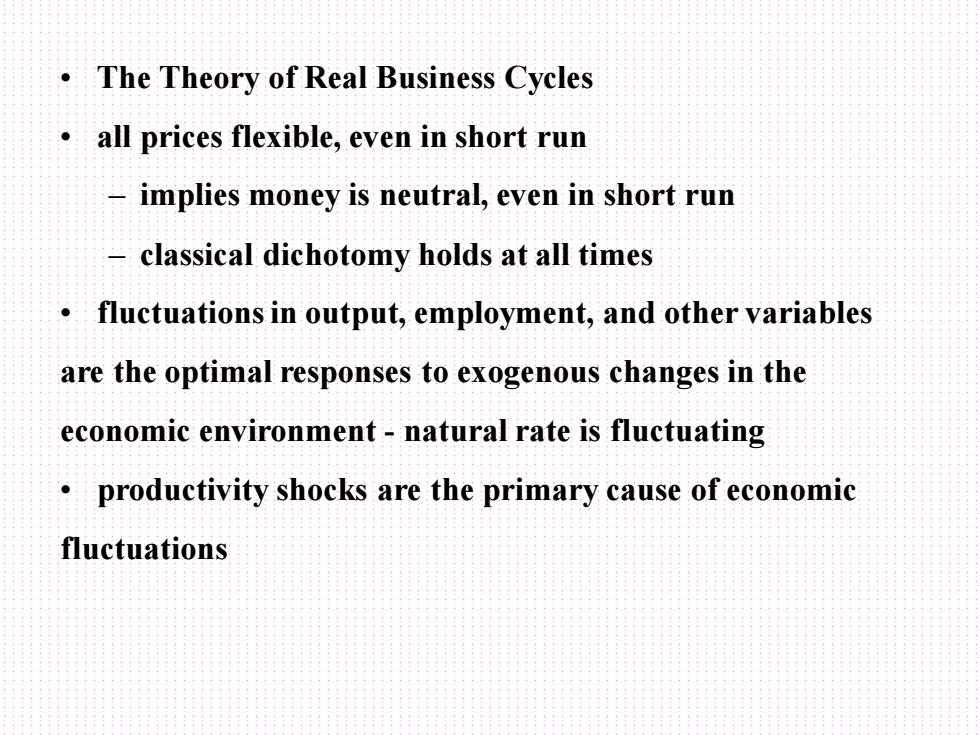
The Theory of Real Business Cycles all prices flexible,even in short run implies money is neutral,even in short run classical dichotomy holds at all times fluctuations in output,employment,and other variables are the optimal responses to exogenous changes in the economic environment-natural rate is fluctuating productivity shocks are the primary cause of economic fluctuations
• The Theory of Real Business Cycles • all prices flexible, even in short run – implies money is neutral, even in short run – classical dichotomy holds at all times • fluctuations in output, employment, and other variables are the optimal responses to exogenous changes in the economic environment - natural rate is fluctuating • productivity shocks are the primary cause of economic fluctuations
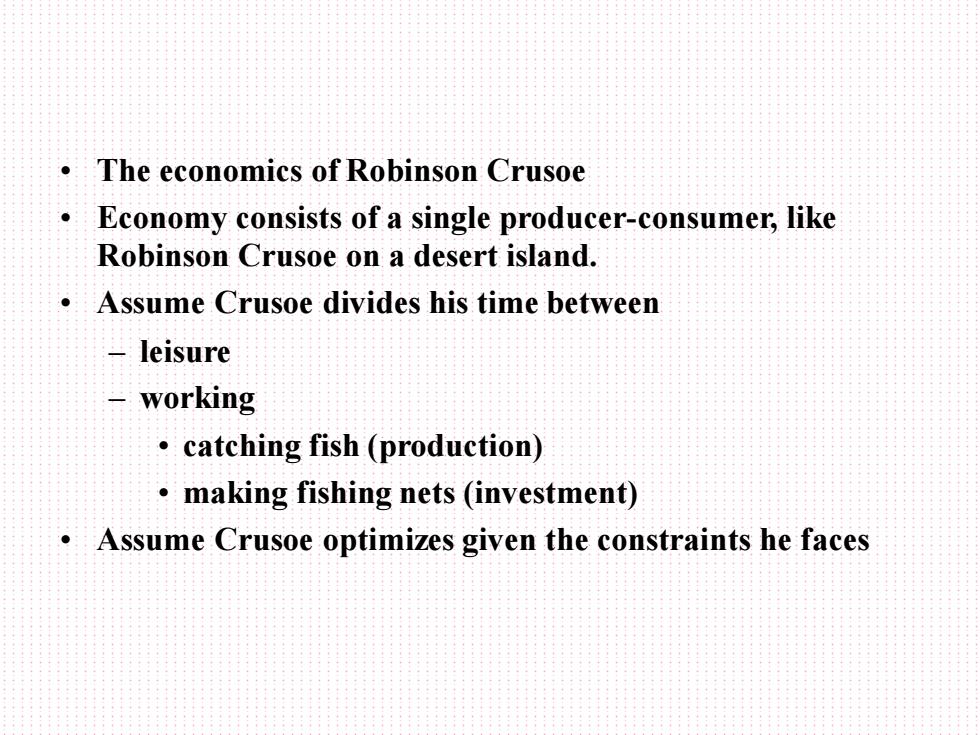
The economics of Robinson Crusoe Economy consists of a single producer-consumer,like Robinson Crusoe on a desert island. Assume Crusoe divides his time between leisure working catching fish(production) .making fishing nets (investment) Assume Crusoe optimizes given the constraints he faces
• The economics of Robinson Crusoe • Economy consists of a single producer-consumer, like Robinson Crusoe on a desert island. • Assume Crusoe divides his time between – leisure – working • catching fish (production) • making fishing nets (investment) • Assume Crusoe optimizes given the constraints he faces
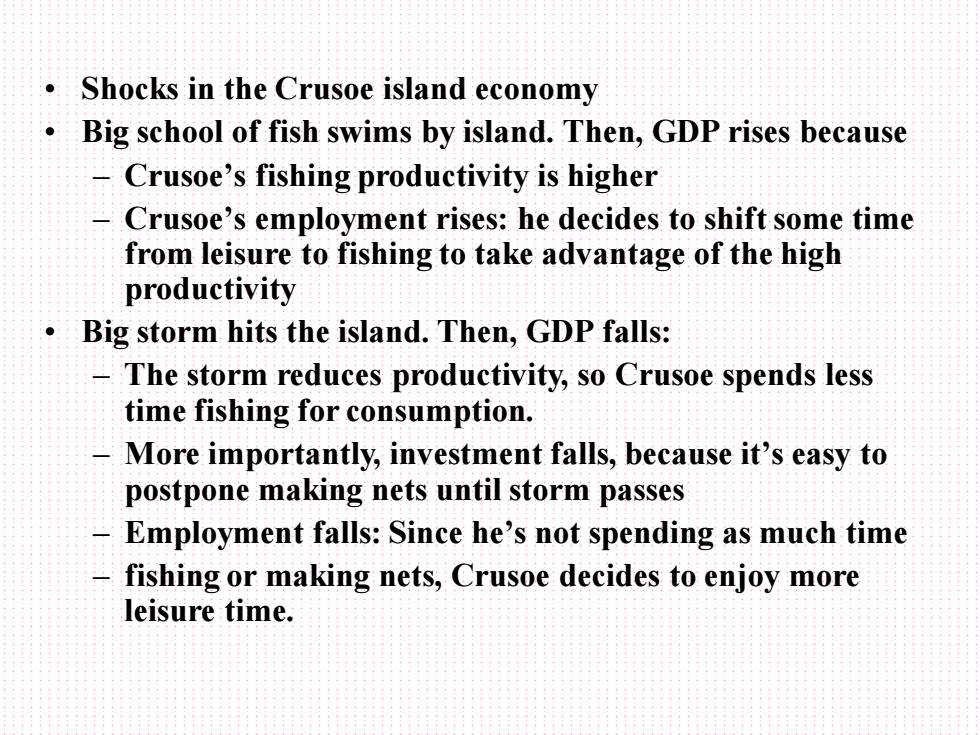
Shocks in the Crusoe island economy Big school of fish swims by island.Then,GDP rises because Crusoe's fishing productivity is higher Crusoe's employment rises:he decides to shift some time from leisure to fishing to take advantage of the high productivity Big storm hits the island.Then,GDP falls: The storm reduces productivity,so Crusoe spends less time fishing for consumption. More importantly,investment falls,because it's easy to postpone making nets until storm passes Employment falls:Since he's not spending as much time fishing or making nets,Crusoe decides to enjoy more leisure time
• Shocks in the Crusoe island economy • Big school of fish swims by island. Then, GDP rises because – Crusoe’s fishing productivity is higher – Crusoe’s employment rises: he decides to shift some time from leisure to fishing to take advantage of the high productivity • Big storm hits the island. Then, GDP falls: – The storm reduces productivity, so Crusoe spends less time fishing for consumption. – More importantly, investment falls, because it’s easy to postpone making nets until storm passes – Employment falls: Since he’s not spending as much time – fishing or making nets, Crusoe decides to enjoy more leisure time

Economic fluctuations as optimal responses to shocks In Real Business Cycle theory,fluctuations in our economy are similar to those in Crusoe's economy. The shocks aren't always desirable.But once they occur, fluctuations in output,employment,and other variables are the optimal responses to them
• Economic fluctuations as optimal responses to shocks • In Real Business Cycle theory, fluctuations in our economy are similar to those in Crusoe’s economy. • The shocks aren’t always desirable. But once they occur, fluctuations in output, employment, and other variables are the optimal responses to them
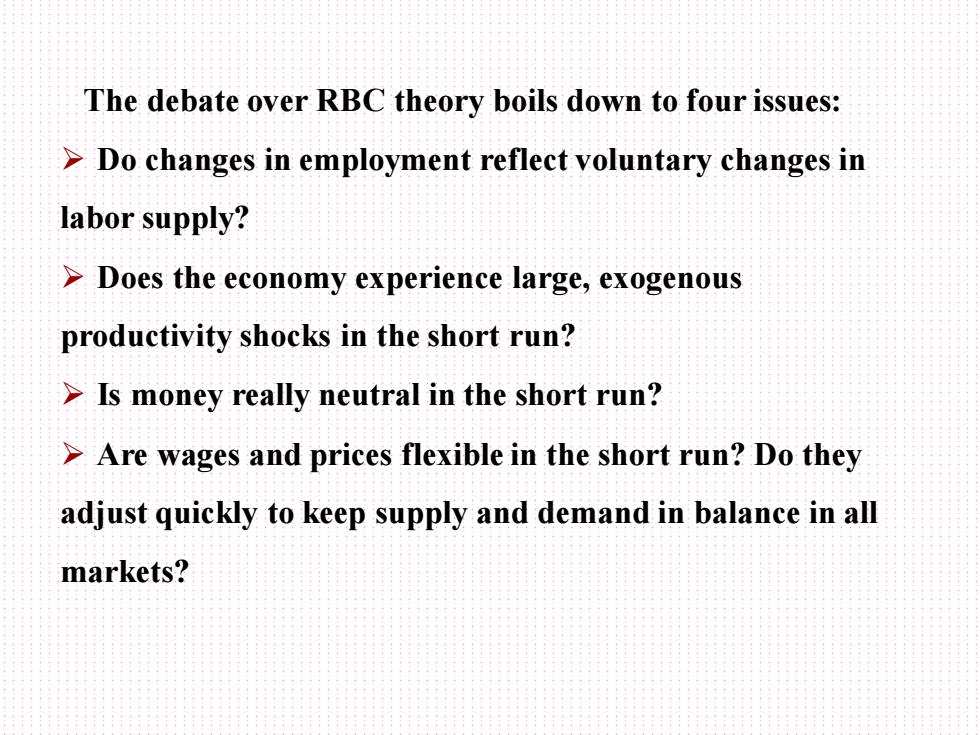
The debate over RBC theory boils down to four issues: Do changes in employment reflect voluntary changes in labor supply? >Does the economy experience large,exogenous productivity shocks in the short run? >Is money really neutral in the short run? >Are wages and prices flexible in the short run?Do they adjust quickly to keep supply and demand in balance in all markets?
The debate over RBC theory boils down to four issues: ➢ Do changes in employment reflect voluntary changes in labor supply? ➢ Does the economy experience large, exogenous productivity shocks in the short run? ➢ Is money really neutral in the short run? ➢ Are wages and prices flexible in the short run? Do they adjust quickly to keep supply and demand in balance in all markets?

The labor market Intertemporal substitution of labor In RBC theory, workers are willing to reallocate labor over time in response to changes in the reward to working now versus later. .The intertemporal relative wage equals where W 1 is the wage in period 1(the present)and W 2 is the wage in period 2 (the future).(1+r)W 1/W2
The labor market • Intertemporal substitution of labor : In RBC theory, workers are willing to reallocate labor over time in response to changes in the reward to working now versus later. • The intertemporal relative wage equals where W 1 is the wage in period 1 (the present) and W 2 is the wage in period 2 (the future). (1+r)W 1 / W 2
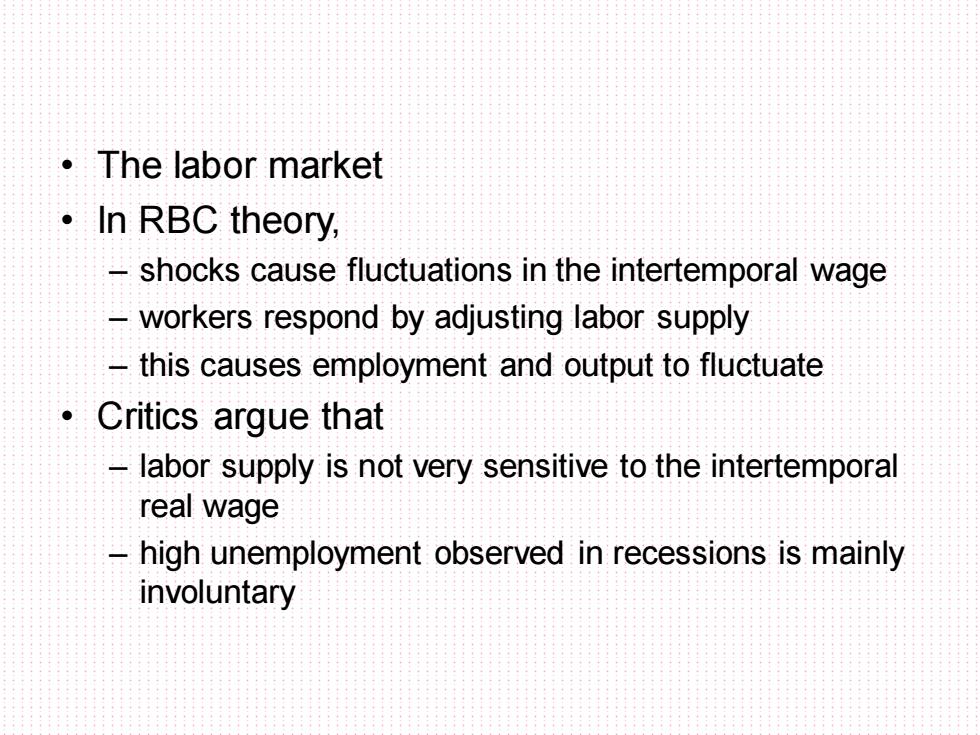
·The labor market ·In RBC theory,. -shocks cause fluctuations in the intertemporal wage -workers respond by adjusting labor supply -this causes employment and output to fluctuate Critics argue that -labor supply is not very sensitive to the intertemporal real wage -high unemployment observed in recessions is mainly involuntary
• The labor market • In RBC theory, – shocks cause fluctuations in the intertemporal wage – workers respond by adjusting labor supply – this causes employment and output to fluctuate • Critics argue that – labor supply is not very sensitive to the intertemporal real wage – high unemployment observed in recessions is mainly involuntary
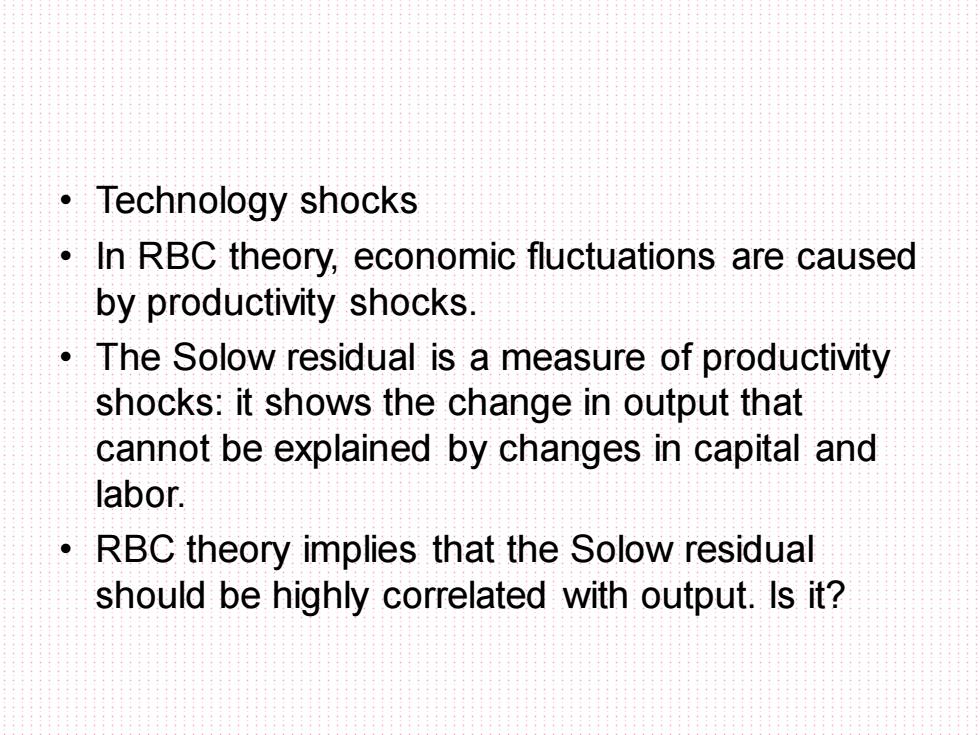
·Technology shocks In RBC theory,economic fluctuations are caused by productivity shocks. The Solow residual is a measure of productivity shocks:it shows the change in output that cannot be explained by changes in capital and labor. RBC theory implies that the Solow residual should be highly correlated with output.Is it?
• Technology shocks • In RBC theory, economic fluctuations are caused by productivity shocks. • The Solow residual is a measure of productivity shocks: it shows the change in output that cannot be explained by changes in capital and labor. • RBC theory implies that the Solow residual should be highly correlated with output. Is it?
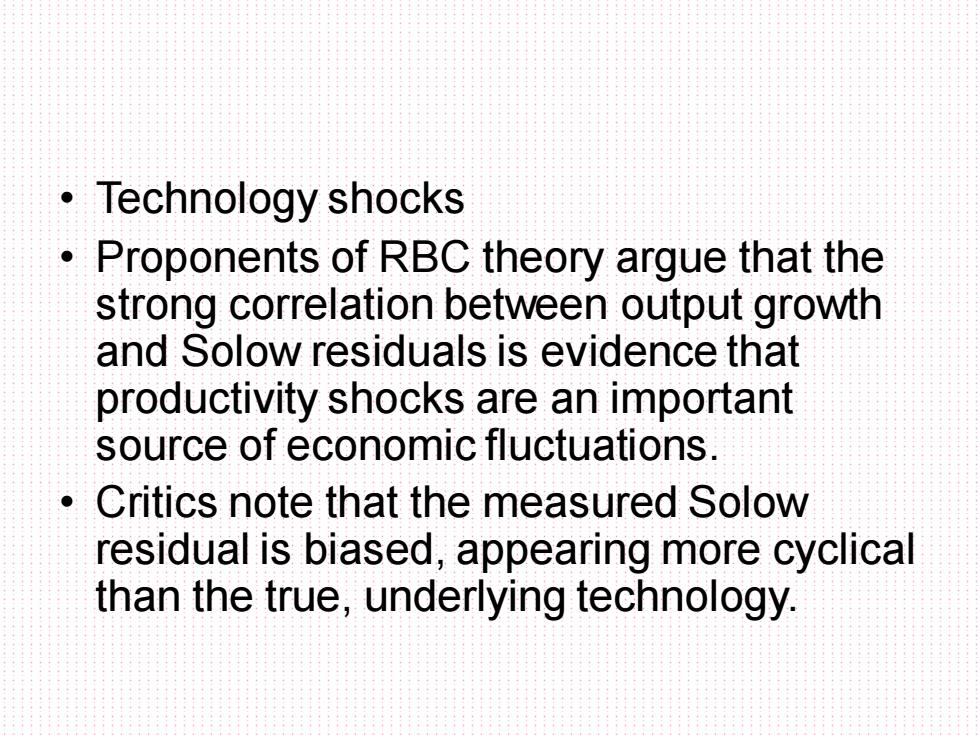
·Technology shocks Proponents of RBC theory argue that the strong correlation between output growth and Solow residuals is evidence that productivity shocks are an important source of economic fluctuations. Critics note that the measured Solow residual is biased,appearing more cyclical than the true,underlying technology
• Technology shocks • Proponents of RBC theory argue that the strong correlation between output growth and Solow residuals is evidence that productivity shocks are an important source of economic fluctuations. • Critics note that the measured Solow residual is biased, appearing more cyclical than the true, underlying technology